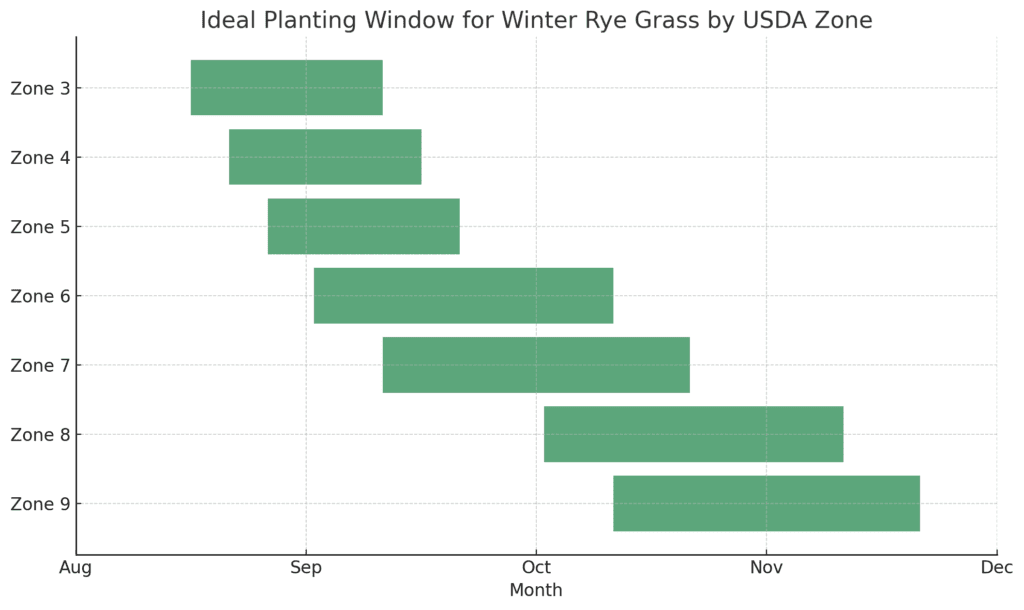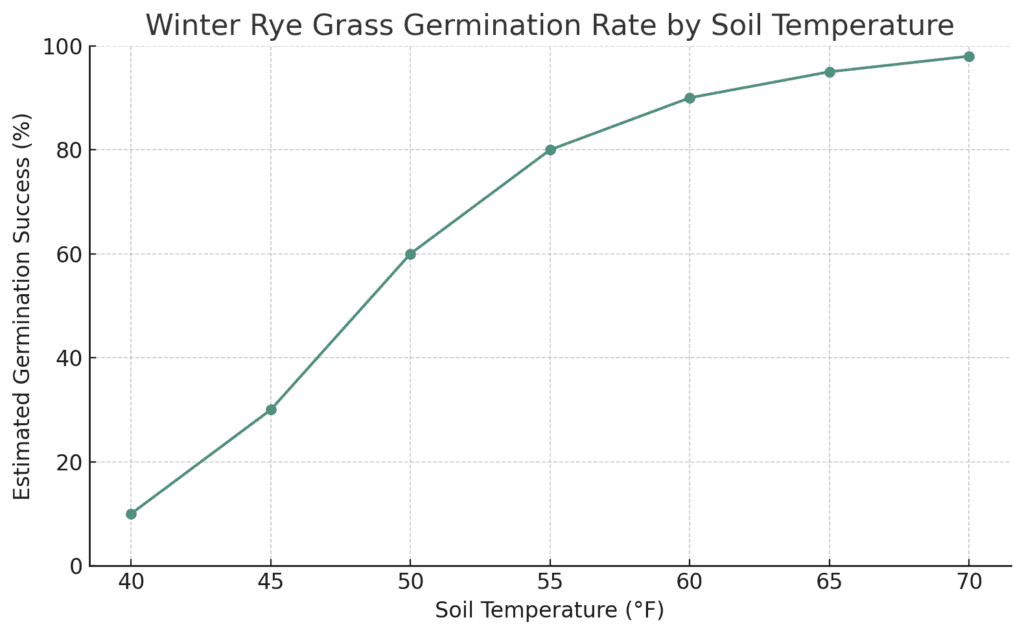You’ve just finished mowing for what feels like the hundredth time this summer, and your lawn’s starting to check out. The heat’s worn it down, bare spots are creeping in, and the calendar says fall is right around the corner. If your warm-season turf is going dormant or you’re staring at thin patches where weeds love to move in, winter rye grass seed might be your best bet.
Let’s walk through exactly when to plant it, what it looks like, how it behaves across seasons, and what to expect once it takes root.

Your lawn’s going brown, should you seed with winter rye grass?
Once August fades and the nighttime temps start dipping, a lot of lawns lose steam. If you’ve got Bermuda or Zoysia, those warm-season grasses naturally start to yellow. Even cool-season lawns can show wear after summer heatwaves or heavy foot traffic.
That’s when homeowners often reach for winter rye grass seed. It’s not a permanent lawn fix, but it does keep things green during months when your main turf is resting. More than that, it protects your soil, suppresses winter weeds, and sets the stage for better spring growth.
Reality Check: If your lawn is still dense and green come fall, overseeding with winter rye may do more harm than good. Competing grasses in the spring can delay green-up and add mowing headaches.
When to plant winter rye grass seed

Let’s say it’s mid-September and the weather app says a cold front’s on the way. You’re right in that transition window when soil is still warm enough to germinate, but the days are cooling fast. That’s prime time to plant.
The soil temp rule
Rye grass needs soil temperatures around 50°F (10°C) or higher to germinate. Penn State Extension explains how soil temperature affects grass seed germination and root strength. If it drops much below that, germination slows and roots stay shallow. That’s why timing matters more than just picking a weekend when you’re free.
Local zone guidance
- In northern climates (Zones 3–5): aim for late August through mid-September.
- In temperate regions (Zones 6–7): shoot for early to mid-October.
- In the South (Zones 8 and up): you’ve got more leeway — October to early November usually works fine.
Pro Tip: Don’t guess on soil temps. A $10 soil thermometer or free frost-date app gives you better odds than crossing your fingers.
What does winter rye grass look like once it sprouts?
You’ll notice thin, upright green shoots poking through in just 5–10 days after seeding, sometimes sooner if conditions stay moist and mild. It has a medium blade width, somewhere between fine fescue and tall turf-type grasses, with a blue-green tone that holds up well into winter.
It doesn’t sprawl or mat down like clover or other ground covers. Instead, it tillers upright, giving you a clean, even look. Great if you’re trying to cover bare ground fast or want to avoid that patchy “just seeded” appearance through the colder months.
Note: Winter rye grass is annual. It lives one season and dies off by early summer. It’s not meant to replace your main lawn long-term, but it’s perfect as a seasonal cover or overseed.
Will rye grass keep growing in winter, and what happens in summer?
You might wonder: does rye grass grow in winter or just hang around looking pretty? The short answer, yes, it grows, especially in regions with milder winters.
Even in colder zones, once established, winter rye will grow slowly through the season, putting on a bit of top growth when daytime highs hit the 40s or 50s. It won’t explode like spring grass, but it stays alive and green when most turf takes a nap.
As summer heat arrives, though, that’s the end of the road.
Why rye fades fast in summer
Once soil temps climb above 75–80°F, winter rye shuts down. It yellows out, dries up, and often disappears altogether by June. If you’ve overseeded on top of dormant Bermuda or another summer grass, that’s fine, your main turf is already waking up. But if you planted rye alone, expect a quick fade unless you’ve got another plan in place.
Warning: Expecting year-round green from winter rye is setting yourself up for disappointment. By late spring, it’s gone, and you’ll need to transition or re-seed accordingly.
Planting winter rye grass seed the right way
Picture this: It’s a crisp October morning, leaves are dropping, and your yard looks like it’s between seasons, because it is. That’s the perfect cue to prep for winter rye.
Prep the ground first
Clear leaves, weeds, and debris. Mow your existing lawn short if you’re overseeding, and rake or dethatch to open up the soil surface. You’re not trying to dig a trench, just give the seed something to grip.
Seeding rates and depth
For solid coverage, go with about 2 pounds of seed per 1,000 square feet. Lightly rake it in or use a spreader for even distribution. Don’t bury it, ½ to 1 inch deep is plenty. Any deeper and you’ll delay or miss germination entirely.
Watering and follow-up
Keep the topsoil moist until seedlings appear. Daily light watering works better than one heavy soak. Once established, winter rainfall usually handles the rest. Mow once it reaches 3–4 inches, just like you would with regular turf.
Pro Tip: If you’re overseeding over dormant warm-season grass, mow as low as you can without scalping before laying down seed. It improves soil contact and prevents competition from old growth.
What to do when rye dies off in summer
By the time June rolls in, you’ll notice the rye turning pale or thinning out. That’s not disease, it’s just nature wrapping up the cycle. Don’t panic. It did its job through the winter and now it’s time to think about next steps.
Transition strategies
If your lawn has warm-season turf underneath, like Bermuda or St. Augustine, just let it take over. You might need to fertilize or mow low to help speed things along. If you used rye as a solo cover, consider reseeding with your preferred warm-season blend or tilling the rye under as green manure to enrich your soil.
Reality Check: Skipping your spring transition plan is a common mistake. If you wait too long after rye fades, weeds will jump in before your main turf fills out.
Call in backup if you’d rather skip the guesswork
If watching weather patterns, checking soil temps, and timing seed just right isn’t your thing, that’s where we come in. Our team at LawnGuru handles rye seeding and seasonal transitions across all regions, with the right timing, tools, and turf blends to match your lawn’s needs.
We’ll get it in before frost, and make sure it’s done right the first time.
Ready to book winter rye seeding? See our overseeding services and get your lawn prepped for winter today.




